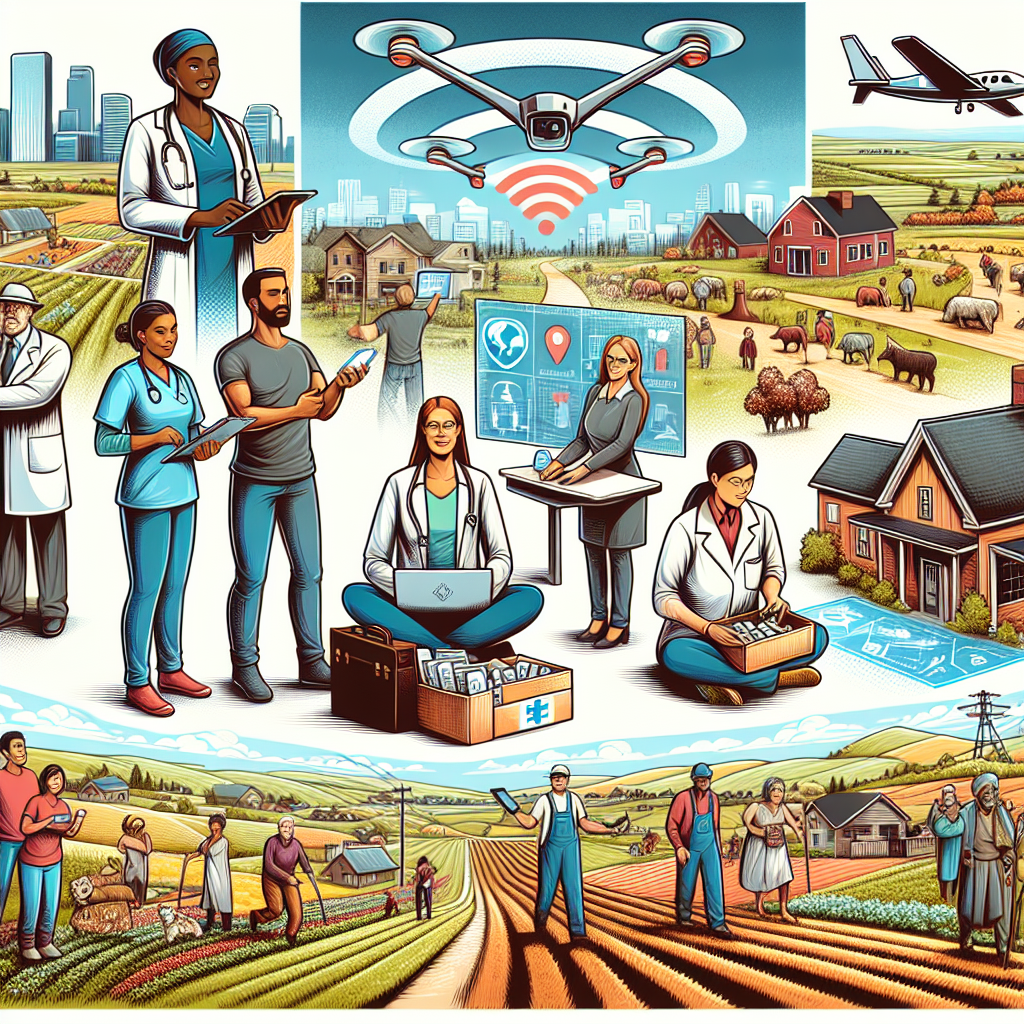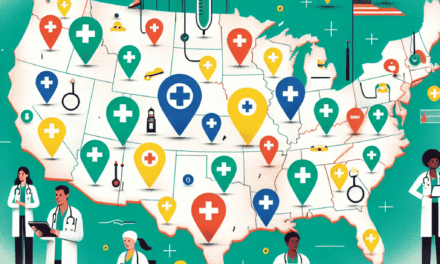Enhancing Healthcare Access in Rural America: Overcoming Challenges and Finding Solutions

Access to healthcare is a fundamental human right, yet millions of Americans living in rural areas face significant barriers to obtaining the care they need. These challenges are multifaceted, involving geographic, economic, and systemic issues that require comprehensive solutions. This article explores the complexities of healthcare access in rural America and examines potential strategies to overcome these obstacles.
Understanding the Challenges of Rural Healthcare Access
Rural America is home to approximately 60 million people, representing nearly 20% of the U.S. population. Despite this significant demographic, rural residents often encounter unique challenges when seeking healthcare services. These challenges can be broadly categorized into geographic, economic, and systemic barriers.
Geographic Barriers
One of the most significant challenges facing rural healthcare is the sheer distance between patients and healthcare providers. Rural areas often lack the density of healthcare facilities found in urban centers, leading to long travel times for patients. This geographic isolation can result in delayed care, exacerbating health conditions and increasing the risk of complications.
For example, a study by the National Rural Health Association found that rural residents travel an average of 17 miles to access basic healthcare services, compared to just 7 miles for urban residents. This distance can be a significant barrier for individuals without reliable transportation or those with mobility issues.
Moreover, the closure of rural hospitals has further compounded this issue. According to the University of North Carolina’s Cecil G. Sheps Center for Health Services Research, over 180 rural hospitals have closed since 2005, leaving many communities without nearby emergency care.
Economic Barriers
Economic factors also play a crucial role in limiting healthcare access for rural populations. Rural areas often have higher rates of poverty and unemployment, which can make healthcare unaffordable for many residents. Additionally, rural jobs are more likely to be in industries that do not offer health insurance, leaving individuals without coverage or facing high out-of-pocket costs.
The lack of insurance coverage is a significant barrier to accessing healthcare services. According to the Kaiser Family Foundation, rural residents are more likely to be uninsured compared to their urban counterparts. This lack of coverage can deter individuals from seeking preventive care or addressing health issues early, leading to more severe health problems down the line.
Furthermore, rural healthcare providers often face financial challenges themselves. Lower patient volumes and higher rates of uninsured patients can strain the financial viability of rural healthcare facilities, leading to closures or reduced services.
Systemic Barriers
Systemic issues within the healthcare system also contribute to the challenges faced by rural communities. A shortage of healthcare professionals is a significant concern, with rural areas experiencing a disproportionate lack of doctors, nurses, and specialists. The Health Resources and Services Administration (HRSA) reports that over 60% of Health Professional Shortage Areas (HPSAs) are located in rural regions.
This shortage is exacerbated by difficulties in recruiting and retaining healthcare professionals in rural areas. Factors such as lower salaries, professional isolation, and limited career advancement opportunities can deter healthcare workers from practicing in these communities.
Additionally, rural healthcare systems often lack the infrastructure and resources needed to provide comprehensive care. Limited access to advanced medical technology and specialized services can force patients to travel long distances for treatment, further straining their access to care.
Innovative Solutions to Improve Rural Healthcare Access
Addressing the challenges of rural healthcare access requires innovative solutions that consider the unique needs of these communities. Several strategies have emerged as promising approaches to improving healthcare access in rural America.
Telehealth and Digital Health Solutions
Telehealth has emerged as a powerful tool for overcoming geographic barriers and expanding access to care in rural areas. By leveraging technology, telehealth allows patients to connect with healthcare providers remotely, reducing the need for long-distance travel.
The COVID-19 pandemic accelerated the adoption of telehealth, with many rural healthcare providers integrating virtual visits into their practice. This shift has proven beneficial for patients with chronic conditions, mental health needs, and those requiring follow-up care.
For example, the Veterans Health Administration (VHA) has successfully implemented telehealth services to reach rural veterans. The VHA’s telehealth program has improved access to care for veterans living in remote areas, providing services such as mental health counseling, primary care, and specialty consultations.
However, the expansion of telehealth in rural areas is not without challenges. Limited broadband access remains a significant barrier, with many rural communities lacking the infrastructure needed for reliable internet connectivity. Addressing this digital divide is crucial for maximizing the potential of telehealth in rural healthcare.
Community Health Workers and Mobile Clinics
Community health workers (CHWs) and mobile clinics are innovative solutions that bring healthcare services directly to rural populations. CHWs are trained individuals who provide health education, support, and basic medical services within their communities. They serve as a bridge between patients and healthcare providers, helping to navigate the healthcare system and address social determinants of health.
Mobile clinics, on the other hand, are equipped vehicles that travel to underserved areas to provide medical services. These clinics can offer a range of services, including preventive care, screenings, vaccinations, and chronic disease management.
Programs like the Mobile Health Map initiative have demonstrated the effectiveness of mobile clinics in improving healthcare access. By bringing services directly to patients, mobile clinics reduce transportation barriers and increase the likelihood of individuals receiving timely care.
Both CHWs and mobile clinics have shown promise in addressing healthcare disparities in rural areas. By leveraging local resources and community engagement, these models can enhance healthcare access and improve health outcomes for rural populations.
Policy Interventions and Funding Initiatives
Policy interventions and funding initiatives play a critical role in addressing the systemic challenges of rural healthcare access. Federal and state governments have implemented various programs to support rural healthcare providers and improve access to care.
The Rural Health Clinic (RHC) program, for example, provides financial incentives to healthcare providers in rural areas. RHCs receive enhanced reimbursement rates for Medicare and Medicaid services, helping to offset the financial challenges faced by rural providers.
Additionally, the National Health Service Corps (NHSC) offers loan repayment and scholarship programs to healthcare professionals who commit to working in underserved areas. These programs aim to attract and retain healthcare workers in rural communities, addressing workforce shortages.
Funding initiatives such as the Rural Health Care Program provide financial support for telecommunication services in rural healthcare facilities. By subsidizing the cost of broadband connectivity, these programs help expand telehealth services and improve access to care.
Policy interventions and funding initiatives are essential for creating a supportive environment for rural healthcare providers and ensuring that rural residents have access to quality care.
Case Studies: Successful Models of Rural Healthcare Access
Examining successful models of rural healthcare access can provide valuable insights into effective strategies for overcoming challenges. Several case studies highlight innovative approaches that have improved healthcare access in rural communities.
The Alaska Community Health Aide Program
The Alaska Community Health Aide Program (CHAP) is a pioneering model that addresses healthcare access in remote and isolated communities. Established in the 1960s, CHAP trains local residents to become Community Health Aides (CHAs) who provide primary care services in their communities.
CHAs are trained to diagnose and treat common illnesses, manage chronic conditions, and provide preventive care. They work under the supervision of licensed healthcare providers and have access to telehealth consultations for more complex cases.
The success of CHAP lies in its community-based approach, which empowers local residents to take an active role in their healthcare. By leveraging local resources and cultural knowledge, CHAP has improved healthcare access and outcomes for Alaska Native communities.
The Project ECHO Model
Project ECHO (Extension for Community Healthcare Outcomes) is an innovative model that uses tele-mentoring to expand access to specialty care in rural areas. Developed at the University of New Mexico, Project ECHO connects primary care providers in rural areas with specialists through virtual clinics.
Through regular video conferences, primary care providers present patient cases to a team of specialists who provide guidance and support. This model allows rural providers to enhance their skills and knowledge, enabling them to manage complex cases locally.
Project ECHO has been successfully implemented in various healthcare domains, including hepatitis C treatment, mental health, and chronic pain management. By democratizing medical knowledge, Project ECHO has improved access to specialty care and reduced the need for patients to travel long distances for treatment.
The Rural Health Information Hub
The Rural Health Information Hub (RHIhub) is a comprehensive online resource that provides information and tools to support rural healthcare providers and policymakers. Funded by the Federal Office of Rural Health Policy, RHIhub offers a wealth of resources on rural health issues, funding opportunities, and best practices.
RHIhub’s online library includes case studies, toolkits, and research articles that highlight successful models of rural healthcare access. By sharing knowledge and resources, RHIhub empowers rural communities to implement effective strategies and improve healthcare access.
The success of RHIhub lies in its ability to connect rural healthcare providers with valuable information and support. By fostering collaboration and knowledge sharing, RHIhub has become a vital resource for addressing rural healthcare challenges.
Future Directions: Building a Sustainable Rural Healthcare System
Building a sustainable rural healthcare system requires a multifaceted approach that addresses the unique needs of rural communities. By leveraging technology, community resources, and policy interventions, we can create a healthcare system that is accessible, equitable, and resilient.
Expanding Broadband Access
Expanding broadband access is a critical step in improving healthcare access in rural areas. Reliable internet connectivity is essential for telehealth services, electronic health records, and other digital health solutions.
Federal and state governments have recognized the importance of broadband access and have implemented initiatives to expand connectivity in rural areas. Programs such as the Federal Communications Commission’s (FCC) Rural Digital Opportunity Fund aim to bridge the digital divide and ensure that rural communities have access to high-speed internet.
By investing in broadband infrastructure, we can enhance the reach and effectiveness of telehealth services, improving healthcare access for rural residents.
Strengthening the Rural Healthcare Workforce
Addressing workforce shortages is crucial for building a sustainable rural healthcare system. Strategies to strengthen the rural healthcare workforce include:
- Expanding loan repayment and scholarship programs for healthcare professionals who commit to working in rural areas.
- Providing incentives for healthcare providers to practice in rural communities, such as tax breaks and housing assistance.
- Enhancing training and education programs to prepare healthcare professionals for the unique challenges of rural practice.
- Promoting tele-mentoring and continuing education opportunities to support rural providers in managing complex cases.
By investing in the rural healthcare workforce, we can ensure that rural communities have access to skilled and dedicated healthcare professionals.
Promoting Community Engagement and Collaboration
Community engagement and collaboration are essential for building a healthcare system that meets the needs of rural residents. By involving community members in the planning and implementation of healthcare initiatives, we can ensure that solutions are culturally appropriate and responsive to local needs.
Collaboration between healthcare providers, community organizations, and policymakers can also enhance the effectiveness of rural healthcare initiatives. By working together, stakeholders can leverage resources, share knowledge, and develop innovative solutions to address healthcare challenges.
Promoting community engagement and collaboration fosters a sense of ownership and empowerment among rural residents, leading to improved health outcomes and a more resilient healthcare system.
Conclusion
Enhancing healthcare access in rural America is a complex challenge that requires a comprehensive and collaborative approach. By understanding the unique barriers faced by rural communities and implementing innovative solutions, we can improve healthcare access and outcomes for millions of Americans.
Telehealth, community health workers, policy interventions, and successful models like Project ECHO and the Alaska Community Health Aide Program offer valuable insights into effective strategies for overcoming rural healthcare challenges. By expanding broadband access, strengthening the rural healthcare workforce, and promoting community engagement, we can build a sustainable and equitable healthcare system for rural America.
Ultimately, improving healthcare access in rural areas is not only a matter of equity but also a critical step toward ensuring the health and well-being of all Americans. By working together, we can create a healthcare system that leaves no one behind.





